A Love Story, Part 4 of 5
/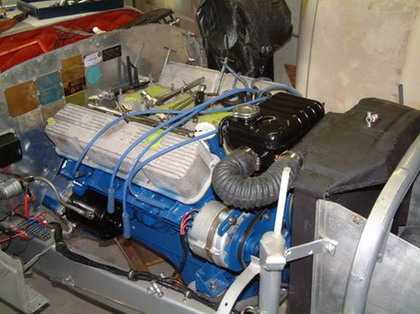
Click here to start from the beginning...
I had been working on the car for about 12 hours when I quit for the this June day, went to the house, had supper and went to bed. About midnight I woke up with chills and a fever of 104. Early the next morning I headed for the emergency room where they admitted me to the hospital with pneumonia. A week later I came home but was too weak to work on the car. This set me back a whole month. At this point I was not sure that I could complete the restoration by the October deadline. (A word of caution for those of you who spray paint: even though I used a proper mask and filters I think the cause of my pneumonia was due to paint fumes. My recommendation – get a respirator with an outside air supply). During this month I did do some machine work and fabricated new door latches from brass, then had them chrome plated.
After I recovered, I started working seven days a week, 12-hour a day – hoping I could complete the car on time. I decided to install the engine with the transmission attached in an effort to save some time. With my son’s help, we raised the frame to the full height of the truck jack stands, which allowed the engine to be lowered at a steep angle, finally resting it on the floor under the frame. The engine with transmission attached was then raised parallel to the frame, up and over the mounts, and secured in place. I then found that the transmission mounts required modification to match them up with the mounts on the frame. This required fabricating an adapter that would bring the mounts in alignment. Another day and a half lost.
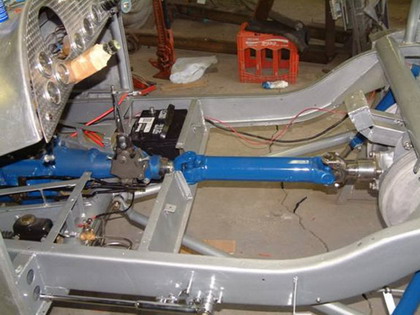
The open drive shaft installed— the new adapter is on the rear end.
The new stainless steel brake lines had been installed previously and were fitted so dual master cylinders can be installed later. The radiator was installed with the new fan attached to the front, as there is no room to mount it on the back. All the wiring was hooked up and the new Hurst gear-shift installed. It was at this point that I found that there was a clearance problem with the gear-shift rods to the transmission. By trial and error they were bent to provide proper clearance and still allow them to function properly. Another two days lost.
It was now time to start installing the floorboards and the 45 gal. gas tank. A new copper gas line had to be run inside the frame, as the old one was damaged during removal,
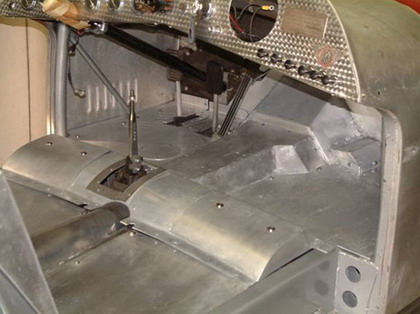
Fitting the floorboards and seats.
I had previously ordered rebuild kits for the three carburetors. These kits were still available from Holly. The carburetors were rebuilt and installed and the linkage connected. The old exhaust headers were still in good shape, so they were cleaned and painted with high temperature paint, and then wrapped with insulation. The insulation of the headers and collector pipes has helped to lower the temperature in both the engine compartment and the cowl. I blistered my foot once during a long race from engine heat on the aluminum floorboards.
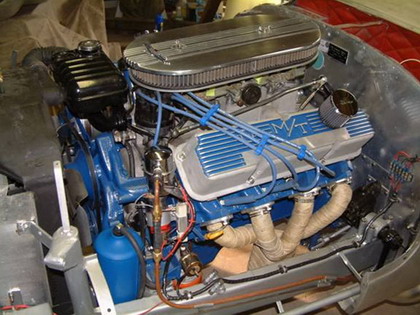
Fitted engine installation with insulated headers
With less than a month to go the moment of truth was at hand. Time to start the engine and test-drive the car without the body installed. I worried about the restoration as I had done it so quickly. Perhaps I had left something undone, or perhaps I had failed to complete a necessary step. Hopefully such would not be the case. With my son present I got in and was going to start when I remembered that the fire extinguisher was in the house. I learned long ago to never, ever start a restored engine without a fire extinguisher at hand in case of a screw-up somewhere.
With the extinguisher at hand I turned the key to ON and the gauges came alive. Then I pulled the ‘petrol’ switch to ON. The electric fuel pump started its fast chattering, but it kept on and on without slowing as it normally would. That’s when I noticed that gasoline was pouring out onto the manifold. One of the three carburetors floats was stuck so the start-up was aborted. We sopped up the gasoline, adjusted the floats, and began the starting sequence was again. This time the electric pump started to slow so I pumped the accelerator twice and pressed the starter button. The engine fired with a loud bang, but was running rough – indicating that the carbs needed their slow speed jets adjusted. After adjustment it settled into the normal lope of a race engine. Gosh!! It sounded good to hear it again after almost 13 years of silence.
The gauges indicated that everything was normal and working, so I tried unsuccessfully to put it in reverse. The shifter and the clutch needed adjusting and the linkage was tight. I spent about an hour adjusting all three and was able to shift properly though it was very stiff. I started backing out the garage and checked the brakes before I drove it up to my son’s house and back without incident.
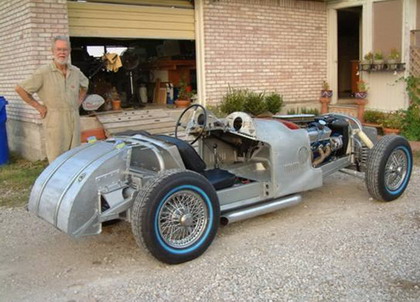
The shakedown at my Son’s house.
With the shakedown cruise complete, it was time to start cleaning and painting the body. There are three major sections to the body, the center section, the nose and the tail. After that there are the doors, the front fenders, the removable side panels for access to the engine and the hood – or ‘bonnet’ as the English call it. With only a month left I spent every hour I could on finishing the car. I decided to do the upholstery later as there was no way that I could do it in the time left.

